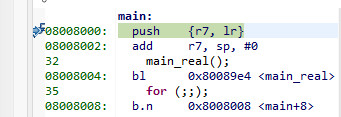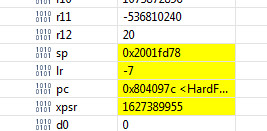See my post above. KDE_main_stub is shown (in the .map file) at 0x8008000, which is right. It's just that there isn't any code at that address, so that function has been stripped out, presumably because nothing is calling it.
You are right; this is a funny way to do it. I think the problem appears because I am trying to build the whole project (boot block and the "overlay") in one go, which absolutely does work, not least because the boot block
calls the first function in the overlay (main()), whereas if I create a separate Cube "devkit" for somebody, which just builds the "overlay", located at 0x8008000, they won't have the problem because, one hopes, nothing is going to strip out
their main(). But why will their main() not get stripped out? My guess is that in the arm32/gcc setup, a vector is always pointing at main(), so main() can be anywhere within the FLASH.
So what can I do to prevent main() getting stripped out here? I've tried everything I can think of. Maybe I should point some unused vector (table at 0x8008000+0x200) at it

Not kidding - that does actually work! Asm code is not optimised out. But causes some other issue. Another way which works is to reference main() with this, where the code after the asm(... is never executed

Unfortunately both above methods cause a hard fault handler IRQ0, after this point


where the code looks plausible, SP is 0x2001fd98 which is ok... This is the hard fault data

I wonder if this hex dump of memory at 8008000 gives a clue. Bit 1 is not 1, is it?

The trap is generated by the push r7, lr instruction. r7=0, lr=0x800163d. Is that a write into FLASH? Maybe in GCC C you cannot just jump to a C function. Maybe some setup is needed first. But I struggle to see a significant difference between jumping to main() and calling main() from C, in terms of register values.
It is really stupid for a compiler to be so determined to remove code. I am running the project with -Og, but this module has the -O0 attribute. This is GCC 10. Maybe they were running out of ideas after GCC9?
This stuff used to be so easy.
ORG 0x100
some code
ORG 0x8000
some code
ORG 0xF000
some code
etc
and it all worked.